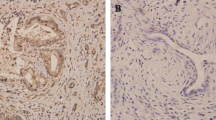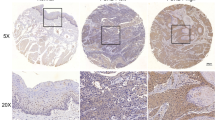Abstract
Sex-determining region Y (SRY)-box protein 1 (SOX 1) has been reported to have the inhibiting effects on various cancer cells; however, the expression and effect of SOX 1 on laryngeal squamous cell carcinoma (LSCC) have not been determined. Therefore, the aim of this study was to assess the anti-proliferation and metastatic effects of SOX 1 and its related mechanisms on LSCC. According to our present study, first, we found that overexpression of SOX 1 could significantly inhibit proliferation and promote apoptosis in Tu212 cells. Additionally, overexpression of SOX 1 suppressed the migration and invasion potential of Tu212 cells via regulating Wnt/β-catenin pathway. Finally, we demonstrated for the first time that overexpression of SOX 1 could downregulate the expression of SOX 2, and co-expression of SOX 1 and SOX 2 could reverse the anti-tumor effect of SOX 1. In conclusion, our studies suggested that SOX 1 suppressed cell growth and invasion in Tu212 cells by inhibiting Wnt/β-catenin pathway, and the anti-tumor effect of SOX 1 could be weakened by SOX 2, which may be a potential molecular basis for clinical treatment of LSCC.





Similar content being viewed by others
References
Hunter KD, Parkinson EK, Harrison PR. Profiling early head and neck cancer. Nat Rev Cancer. 2005;5:127–35.
Wu H, Liu T, Wang R, Tian S, Liu M, Li X, et al. Microrna-16 targets zyxin and promotes cell motility in human laryngeal carcinoma cell line HEp-2. IUBMB Life. 2011;63:101–8.
Fleskens SA, van der Laak JA, Slootweg PJ, Takes RP. Management of laryngeal premalignant lesions in The Netherlands. Laryngoscope. 2010;120:1326–35.
Ren J, Zhu D, Liu M, Sun Y, Tian L. Downregulation of miR-21 modulates Ras expression to promote apoptosis and suppress invasion of laryngeal squamous cell carcinoma. Eur J Cancer. 2010;46:3409–16.
Cosetti M, Yu GP, Schantz SP. Five-year survival rates and time trends of laryngeal cancer in the US population. Arch Otolaryngol Head Neck Surg. 2008;134:370–9.
Hu Y, Liu H. Diagnostic variability of laryngeal premalignant lesions: histological evaluation and carcinoma transformation. Otolaryngol Head Neck Surg. 2014;150:401–6.
Gubbay J, Collignon J, Koopman P, Capel B, Economou A, Munsterberg A, et al. A gene mapping to the sex-determining region of the mouse y chromosome is a member of a novel family of embryonically expressed genes. Nature. 1990;346:245–50.
Chew LJ, Gallo V. The Yin and Yang of Sox proteins: activation and repression in development and disease. J Neurosci Res. 2009;87:3277–87.
Otsubo T, Akiyama Y, Yanagihara K, Yuasa Y. Sox2 is frequently downregulated in gastric cancers and inhibits cell growth through cell-cycle arrest and apoptosis. Br J Cancer. 2008;98:824–31.
Tian T, Zhang Y, Wang S, Zhou J, Xu S. Sox2 enhances the tumorigenicity and chemoresistance of cancer stem-like cells derived from gastric cancer. J Biomed Res. 2012;26:336–45.
Matsuoka J, Yashiro M, Sakurai K, Kubo N, Tanaka H, Muguruma K, et al. Role of the stemness factors sox2, oct3/4, and nanog in gastric carcinoma. J Surg Res. 2012;174:130–5.
Lin YW, Tsao CM, Yu PN, Shih YL, Lin CH, Yan MD. Sox1 suppresses cell growth and invasion in cervical cancer. Gynecol Oncol. 2013;131:174–81.
Tsao CM, Yan MD, Shih YL, Yu PN, Kuo CC, Lin WC, et al. Sox1 functions as a tumor suppressor by antagonizing the WNT/beta-catenin signaling pathway in hepatocellular carcinoma. Hepatology. 2012;56:2277–87.
Chang CC, Huang RL, Wang HC, Liao YP, Yu MH, Lai HC. High methylation rate of LMX1A, NKX6-1, PAX1, PTPRR, SOX1, AND ZNF582 genes in cervical adenocarcinoma. Int J Gynecol Cancer. 2014;24:201–9.
Shih YL, Hsieh CB, Yan MD, Tsao CM, Hsieh TY, Liu CH, et al. Frequent concomitant epigenetic silencing of SOX1 and secreted frizzled-related proteins (SFRPS) in human hepatocellular carcinoma. J Gastroenterol Hepatol. 2013;28:551–9.
Yang N, Hui L, Wang Y, Yang H, Jiang X. Sox2 promotes the migration and invasion of laryngeal cancer cells by induction of MMP-2 via the PI3K/Akt/mTOR pathway. Oncol Rep. 2014;31:2651–9.
Yang N, Hui L, Wang Y, Yang H, Jiang X. Overexpression of SOX2 promotes migration, invasion, and epithelial-mesenchymal transition through the Wnt/beta-catenin pathway in laryngeal cancer Hep-2 cells. Tumour Biol. 2014;35:7965–73.
Castillo SD, Sanchez-Cespedes M. The SOX family of genes in cancer development: biological relevance and opportunities for therapy. Expert Opin Ther Targets. 2012;16:903–19.
Zhang S, Li S, Gao JL. Promoter methylation status of the tumor suppressor gene SOX11 is associated with cell growth and invasion in nasopharyngeal carcinoma. Cancer Cell Int. 2013;13:109.
Li JY, Han C, Zheng LL, Guo MZ. Epigenetic regulation of Wnt signaling pathway gene SRY-related Hmg-box 17 in papillary thyroid carcinoma. Chin Med J (Engl). 2012;125:3526–31.
Chan DW, Mak CS, Leung TH, Chan KK, Ngan HY. Down-regulation of Sox7 is associated with aberrant activation of Wnt/b-catenin signaling in endometrial cancer. Oncotarget. 2012;3:1546–56.
Lai HC, Lin YW, Huang TH, Yan P, Huang RL, Wang HC, et al. Identification of novel DNA methylation markers in cervical cancer. Int J Cancer. 2008;123:161–7.
Su HY, Lai HC, Lin YW, Chou YC, Liu CY, Yu MH. An epigenetic marker panel for screening and prognostic prediction of ovarian cancer. Int J Cancer. 2009;124:387–93.
Vural B, Chen LC, Saip P, Chen YT, Ustuner Z, Gonen M, et al. Frequency of SOX group b (SOX1, 2, 3) and ZIC2 antibodies in Turkish patients with small cell lung carcinoma and their correlation with clinical parameters. Cancer. 2005;103:2575–83.
Eom BW, Jo MJ, Kook MC, Ryu KW, Choi IJ, Nam BH, et al. The lymphangiogenic factor SOX 18: a key indicator to stage gastric tumor progression. Int J Cancer. 2012;131:41–8.
Sun M, Uozaki H, Hino R, Kunita A, Shinozaki A, Ushiku T, et al. SOX9 expression and its methylation status in gastric cancer. Virchows Arch. 2012;460:271–9.
Vervoort SJ, van Boxtel R, Coffer PJ. The role of SRY-related HMG box transcription factor 4 (SOX4) in tumorigenesis and metastasis: friend or foe? Oncogene. 2013;32:3397–409.
Tan LP, Ng BK, Balraj P, Lim PK, Peh SC. No difference in the occurrence of mismatch repair defects and APC and CTNNB1 genes mutation in a multi-racial colorectal carcinoma patient cohort. Pathology. 2007;39:228–34.
Bryja V, Cajanek L, Grahn A, Schulte G. Inhibition of endocytosis blocks Wnt signalling to beta-catenin by promoting dishevelled degradation. Acta Physiol (Oxf). 2007;190:55–61.
Rhee CS, Sen M, Lu D, Wu C, Leoni L, Rubin J, et al. Wnt and frizzled receptors as potential targets for immunotherapy in head and neck squamous cell carcinomas. Oncogene. 2002;21:6598–605.
Crawford HC, Fingleton BM, Rudolph-Owen LA, Goss KJ, Rubinfeld B, Polakis P, et al. The metalloproteinase matrilysin is a target of beta-catenin transactivation in intestinal tumors. Oncogene. 1999;18:2883–91.
Marchenko GN, Marchenko ND, Leng J, Strongin AY. Promoter characterization of the novel human matrix metalloproteinase-26 gene: regulation by the T-cell factor-4 implies specific expression of the gene in cancer cells of epithelial origin. Biochem J. 2002;363:253–62.
Kapoor A, Li HJ, Leiter AB. Intestinal development: the many faces of Wnt signaling. Gastroenterology. 2007;133:710–2.
Xu J, Chen Y, Olopade OI. Myc and breast cancer. Genes Cancer. 2010;1:629–40.
Dang CV. c-Myc target genes involved in cell growth, apoptosis, and metabolism. Mol Cell Biol. 1999;19:1–11.
Mega S, Miyamoto M, Ebihara Y, Takahashi R, Hase R, Li L, et al. Cyclin d1, E2F1 expression levels are associated with characteristics and prognosis of esophageal squamous cell carcinoma. Dis Esophagus. 2005;18:109–13.
Mauro L, Pellegrino M, Giordano F, Ricchio E, Rizza P, De Amicis F, Catalano S, Bonofiglio D, Panno ML, Ando S: Estrogen receptor-alpha drives adiponectin effects on cyclin d1 expression in breast cancer cells. FASEB J 2015.
Mishra R, Nagini S, Rana A. Expression and inactivation of glycogen synthase kinase 3 alpha/beta and their association with the expression of cyclin d1 and p53 in oral squamous cell carcinoma progression. Mol Cancer. 2015;14:20.
Wright EM, Snopek B, Koopman P. Seven new members of the Sox gene family expressed during mouse development. Nucleic Acids Res. 1993;21:744.
Acknowledgments
This study was supported by a grant from the Natural Science Foundation of Liaoning Province (No.: 201202287).
Conflicts of interest
None
Author information
Authors and Affiliations
Corresponding author
Rights and permissions
About this article
Cite this article
Yang, N., Wang, Y., Hui, L. et al. SOX 1, contrary to SOX 2, suppresses proliferation, migration, and invasion in human laryngeal squamous cell carcinoma by inhibiting the Wnt/β-catenin pathway. Tumor Biol. 36, 8625–8635 (2015). https://doi.org/10.1007/s13277-015-3389-z
Received:
Accepted:
Published:
Issue Date:
DOI: https://doi.org/10.1007/s13277-015-3389-z




